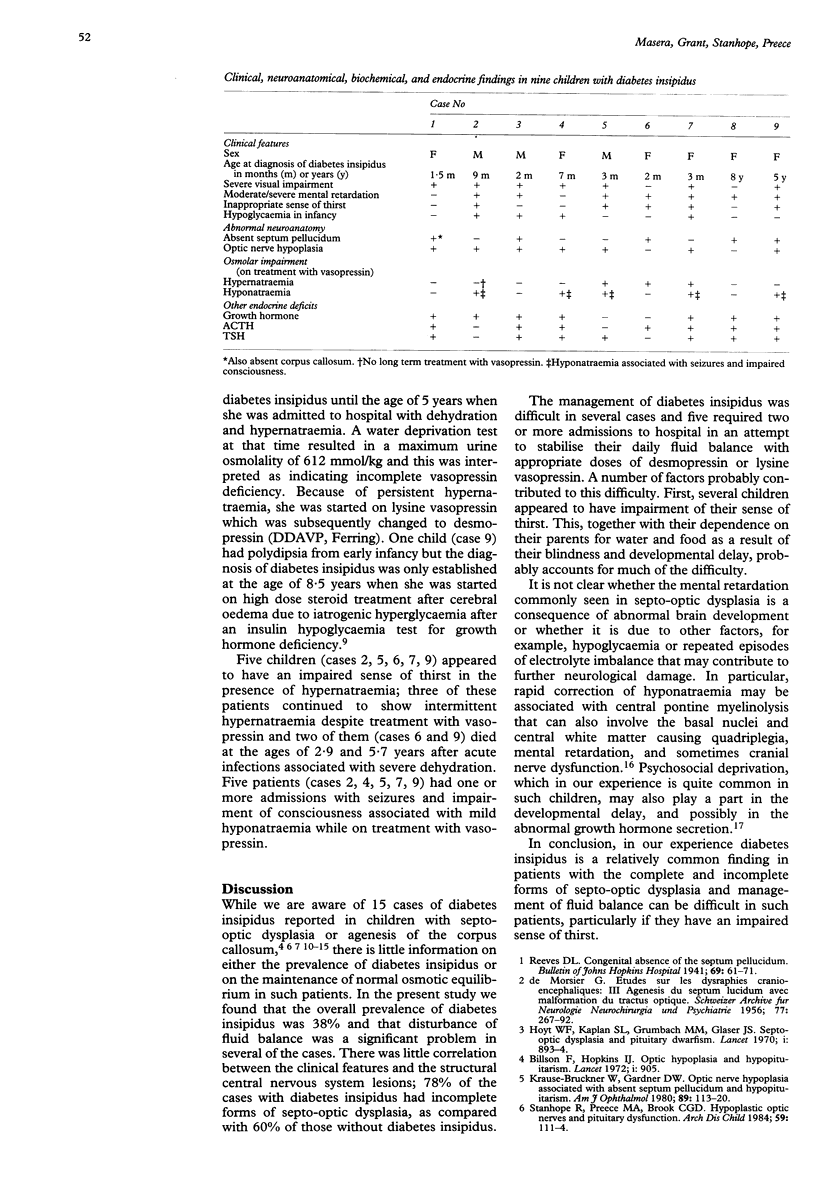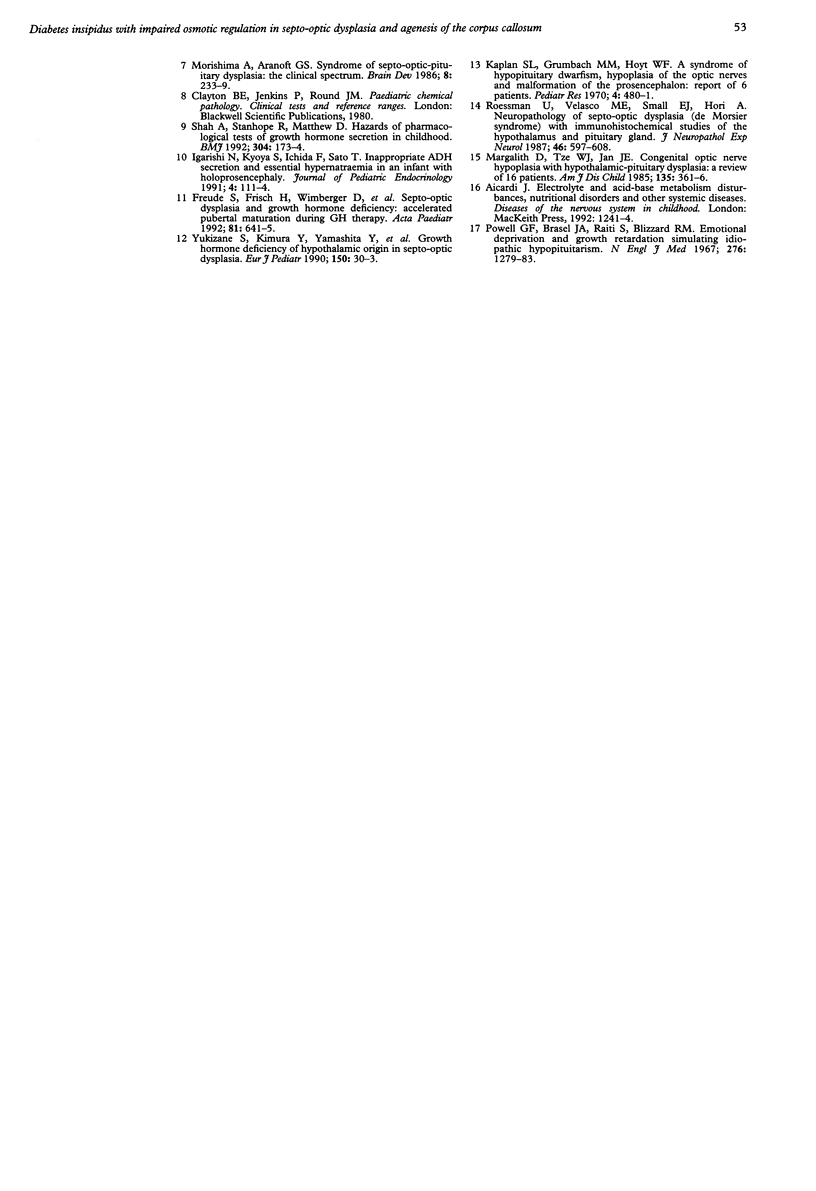Abstract
The clinical and endocrinological findings in 24 children with septo-optic dysplasia and/or agenesis of the corpus callosum are described with particular reference to posterior pituitary function. Nine had diabetes insipidus. The prevalence of diabetes insipidus was similar in children with complete and incomplete forms of septo-optic dysplasia. Maintenance of normal osmotic balance was very difficult in six of these children, even after the introduction of treatment with vasopressin, either as desmopressin, or lysine vasopressin spray in one of the early cases.
Full text
PDF


Selected References
These references are in PubMed. This may not be the complete list of references from this article.
- Billson F., Hopkins I. J. Optic hypoplasia and hypopituitarism. Lancet. 1972 Apr 22;1(7756):905–905. doi: 10.1016/s0140-6736(72)90779-9. [DOI] [PubMed] [Google Scholar]
- DE MORSIER G. Etudes sur les dysraphies crânio-encéphaliques. III. Agénésie du septum lucidum avec malformation du tractus optique; la dysplasie septo-optique. Schweiz Arch Neurol Psychiatr. 1956;77(1-2):267–292. [PubMed] [Google Scholar]
- Freude S., Frisch H., Wimberger D., Schober E., Hüsler G., Waldhauser F., Aichner F. Septo-optic dysplasia and growth hormone deficiency: accelerated pubertal maturation during GH therapy. Acta Paediatr. 1992 Aug;81(8):641–645. doi: 10.1111/j.1651-2227.1992.tb12321.x. [DOI] [PubMed] [Google Scholar]
- Hoyt W. F., Kaplan S. L., Grumbach M. M., Glaser J. S. Septo-optic dysplasia and pituitary dwarfism. Lancet. 1970 Apr 25;1(7652):893–894. doi: 10.1016/s0140-6736(70)91717-4. [DOI] [PubMed] [Google Scholar]
- Krause-Brucker W., Gardner D. W. Optic nerve hypoplasia associated with absent septum pellucidum and hypopituitarism. Am J Ophthalmol. 1980 Jan;89(1):113–120. doi: 10.1016/0002-9394(80)90237-8. [DOI] [PubMed] [Google Scholar]
- Margalith D., Tze W. J., Jan J. E. Congenital optic nerve hypoplasia with hypothalamic-pituitary dysplasia. A review of 16 cases. Am J Dis Child. 1985 Apr;139(4):361–366. doi: 10.1001/archpedi.1985.02140060043025. [DOI] [PubMed] [Google Scholar]
- Morishima A., Aranoff G. S. Syndrome of septo-optic-pituitary dysplasia: the clinical spectrum. Brain Dev. 1986;8(3):233–239. doi: 10.1016/s0387-7604(86)80075-4. [DOI] [PubMed] [Google Scholar]
- Powell G. F., Brasel J. A., Raiti S., Blizzard R. M. Emotional deprivation and growth retardation simulating idiopathic hypopituitarism. II. Endocrinologic evaluation of the syndrome. N Engl J Med. 1967 Jun 8;276(23):1279–1283. doi: 10.1056/NEJM196706082762302. [DOI] [PubMed] [Google Scholar]
- Roessmann U., Velasco M. E., Small E. J., Hori A. Neuropathology of "septo-optic dysplasia" (de Morsier syndrome) with immunohistochemical studies of the hypothalamus and pituitary gland. J Neuropathol Exp Neurol. 1987 Sep;46(5):597–608. doi: 10.1097/00005072-198709000-00008. [DOI] [PubMed] [Google Scholar]
- Shah A., Stanhope R., Matthew D. Hazards of pharmacological tests of growth hormone secretion in childhood. BMJ. 1992 Jan 18;304(6820):173–174. doi: 10.1136/bmj.304.6820.173. [DOI] [PMC free article] [PubMed] [Google Scholar]
- Stanhope R., Preece M. A., Brook C. G. Hypoplastic optic nerves and pituitary dysfunction. A spectrum of anatomical and endocrine abnormalities. Arch Dis Child. 1984 Feb;59(2):111–114. doi: 10.1136/adc.59.2.111. [DOI] [PMC free article] [PubMed] [Google Scholar]
- Yukizane S., Kimura Y., Yamashita Y., Matsuishi T., Horikawa H., Ando H., Yamashita F. Growth hormone deficiency of hypothalamic origin in septo-optic dysplasia. Eur J Pediatr. 1990 Nov;150(1):30–33. doi: 10.1007/BF01959475. [DOI] [PubMed] [Google Scholar]


